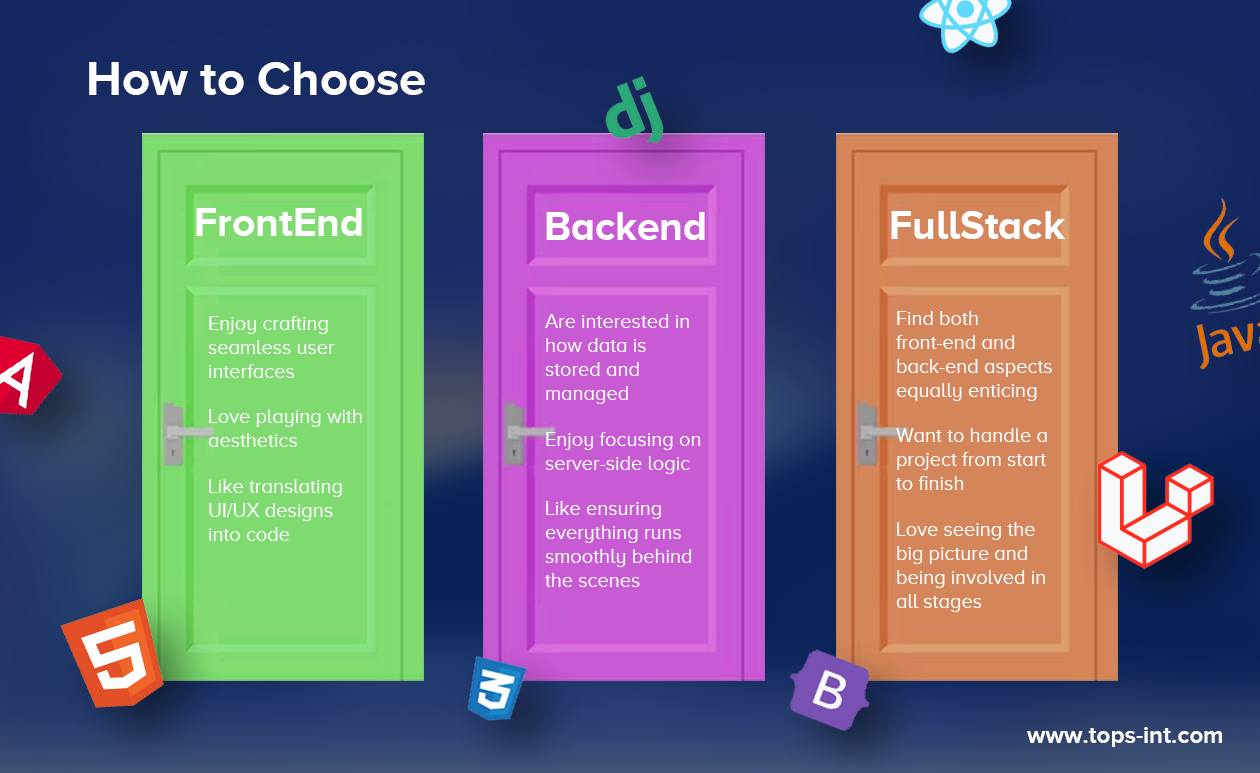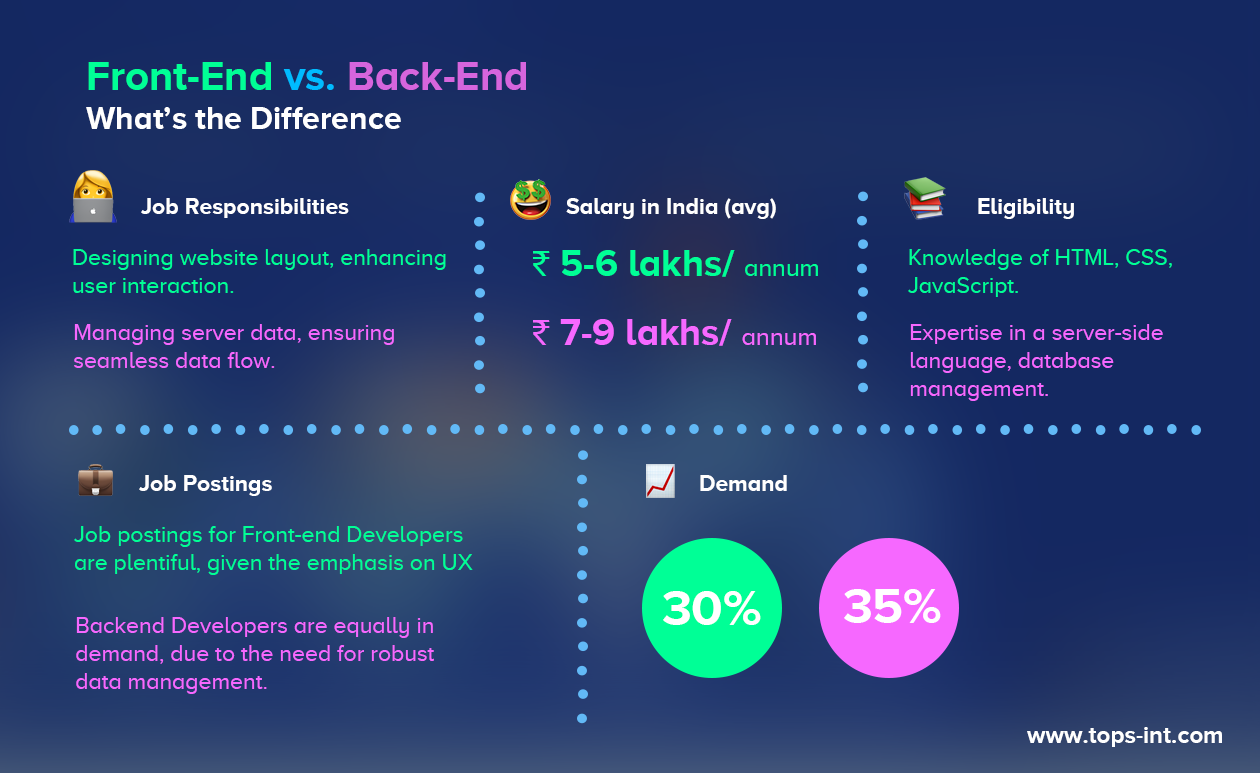Front-End Development involves the part of the web that you see and interact with. Its scope includes everything from designing the website layout to enhancing user experience. Skills like HTML, CSS, and JavaScript are essential, while tools like Angular and React are frequently used. If you live in a tech hub like Ahmedabad, you can easily find affordable Front-End Developer Courses in Ahmedabad!
On the other hand, back-end development focuses on the server side, dealing with databases and server logic. It requires different skills, including knowledge of Python, Java, Node.js, and database technologies like SQL.
The CVs of Riya and Arjun exemplify the perfect blend of technical skills, experience, and individual accomplishments that top tech companies seek in a front-end and back-end developer respectively.
You too can achieve similar success by crafting your CV with a similar focus on skills, experiences, and achievements.
If you'd like to use Riya and Arjun's CVs as a template for crafting your own, you can download them here to give yourself a leg up on your job hunt.
Responsibilities and focus of front-end developers
Here are the skills and responsibilities you will have after completing a Front-End Developer Course in Ahmedabad:
- User Interface (UI) Design and User Experience (UX): Front-end developers create intuitive, user-friendly designs. They ensure that users can navigate and interact with the site seamlessly.
- HTML, CSS, and JavaScript: These are the backbone of front-end development. HTML structures the content, CSS styles it and JavaScript adds interactive elements.
- Key Tools and Frameworks:
- CSS Preprocessors: Tools like SASS and LESS help developers write maintainable and future-proof CSS.
- Frameworks: JavaScript frameworks (like Angular, React.js, and Vue.js) expedite the development process.
- Version Control/Git: These tools help manage different versions of the codebase, allowing for smooth collaboration and efficient debugging.
- Responsive Design: This skill is essential for making sure websites look great on devices of all sizes.
- Browser Developer Tools: Chrome DevTools, Firefox developer tools, etc., allow developers to test and fine-tune their code in real time.
A good front-end developer is a blend of a designer's creativity and a programmer's logic. They balance aesthetic sensitivity with technical prowess to create visually stunning and functionally robust websites.
Responsibilities and focus of back-end developers
Here are the skills and responsibilities you will have after completing a Back-End Developer Course in Ahmedabad:
- Server-side Logic and Database Management: Back-end developers build and maintain the server-side of applications. They are responsible for managing databases, implementing server-side logic, and ensuring high performance and responsiveness.
- Interaction with APIs and Handling Data Storage: They handle the data exchange between the server and users, primarily through APIs. Back-end developers are also responsible for integrating front-end elements with server-side logic.
- Key Programming Languages and Frameworks:
- Languages: Some of the popular ones are Python, Java, Ruby, PHP, and .NET.
- Database Systems: MySQL, MongoDB, PostgreSQL, and Oracle are often used for data storage.
- Server-side Frameworks: Express (Node.js), Django (Python), and Rails (Ruby) are examples of back-end frameworks.
- API Development: Experience with REST and GraphQL APIs is valuable for modern back-end development.
- Server Technologies: Knowledge of server tech like Apache, Nginx, or Microsoft IIS is beneficial.
Back-end developers are the hidden heroes of the web. They work behind the scenes, enabling the magic that front-end users experience. Their work, although invisible to users, is crucial for the functionality of a website or application.
Front-End vs. Back-End: Key Differences
This table sums up the key differences between front-end and back-end development, but remember, they both work in tandem to create the websites and apps we use daily!
Front-End | Back-End |
Focuses on User Interaction, providing the best UI/UX | Works on Server-Side Processing to ensure seamless performance |
Manages Presentation and Layout to visually engage users | Oversees Data Handling and Storage, maintaining data integrity and security |
Enhances Front-End Performance like page load times and rendering speed | Improves Back-End Performance via efficient server response times and database queries |
Implements Front-End Security measures against threats like XSS | Strengthens Back-End Security to protect against issues like SQL injection and server vulnerabilities |
Skill sets revolve around HTML, CSS, JavaScript, and front-end frameworks | Expertise in server-side programming languages, databases, and back-end frameworks |
Professionals can upgrade their skills through an HTML Training Course or a CSS Training Course | Developers can level up through courses in specific server-side languages or database management |
Even if you want to be a Back-End Developer, still choosing TOPS Technologies is a good option because we have more than 15 years of experience in IT training and placements.
How to Choose: Front-End, Back-End, or Full-Stack?

Choosing between front-end, back-end, or full-stack really comes down to where your interests and strengths lie.
- Front-End Development: If you love visual designs, crafting user interfaces, and have a flair for aesthetics, this is for you.
- Back-End Development: If server-side logic, databases, and how the engine behind the scenes works interests you, this path is for you.
- Full-Stack Development: Can't choose between the two? Why not both? Full-Stack means you handle both the front and back end - a complete package.
Don't be afraid to dive in and explore. There's a sea of resources and even courses out there, like a
Full Stack Development Course, that can help you master these skills. It's your journey; steer it the way you want to!
Conclusion
Seeing the growing demand in the IT sector, front-end and back-end development are flourishing careers.
As per stats, there's been a surge in demand of 27% for front-end and 32% for back-end developers in India over the past year.
With the rise in demand, the average salary for both roles has increased by 15%, indicating a promising future.
Diving into a career in development isn't as challenging as it seems, especially with the right guidance. That's where
TOPS Technologies steps in, a leader in IT Training Courses. We offer over 50 specialized courses, including a comprehensive Full Stack Development Course,
Python Certification Course,
Angular Training Course, and many more. Proudly, we've placed over 1 lakh students in over 3000 tie-up companies, with 19 offices across India.
FAQS
Wondering how to start with front-end development?
Start with the basics: HTML, CSS, and JavaScript. Like ours, plenty of online resources and courses can help you get started.
Is a degree necessary for back-end development?
While a degree can be beneficial, many successful developers are self-taught or have completed professional courses.
How long does it take to become a full-stack developer?
Generally, it takes several months to become proficient, depending on the dedication and time invested.
Which programming languages should a back-end developer learn?
Common languages include Java, Python, Ruby, and PHP. The choice depends on your interest and the industry you aim to work in.
Are front-end or back-end developers more in demand?
Demand is high, but the need may vary based on the specific project or company. With a Full Stack Development Course, you can be versatile and open up more opportunities.







